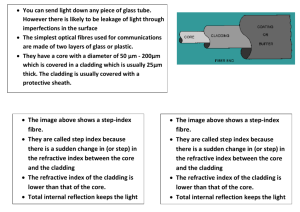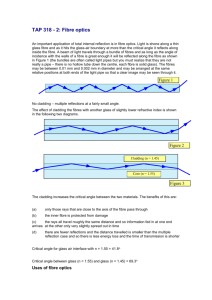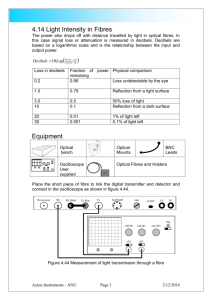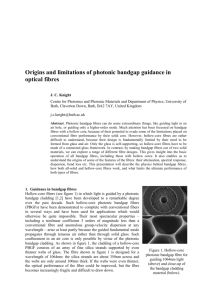Photonic bandgap fibre based on a 2-d array of
advertisement
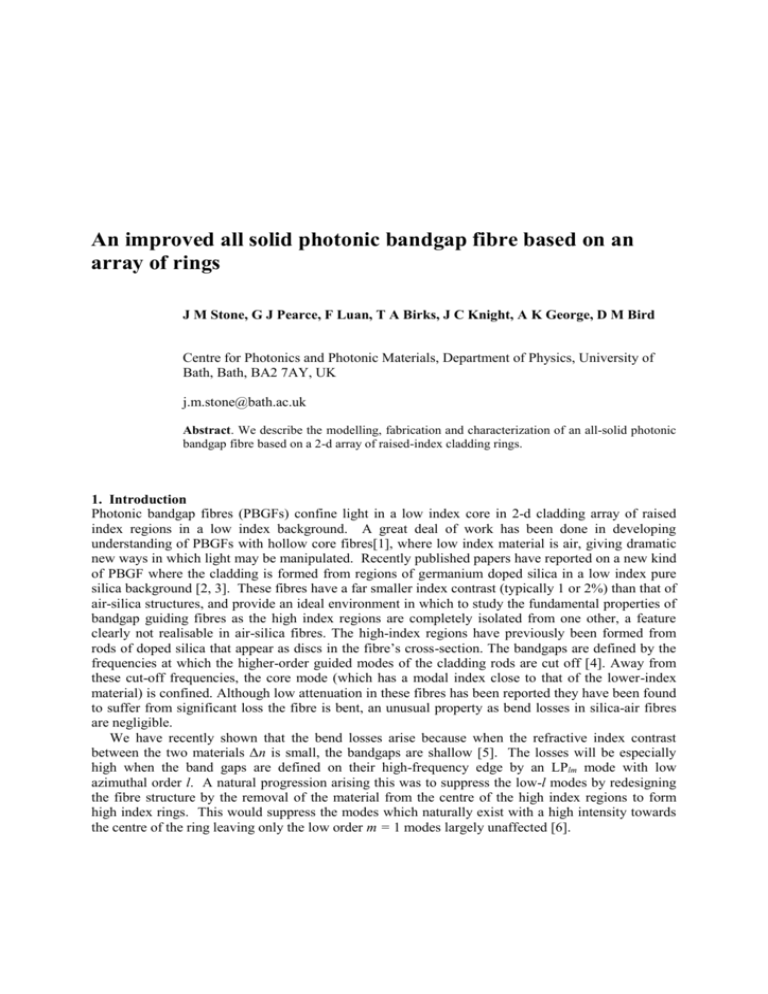
An improved all solid photonic bandgap fibre based on an array of rings J M Stone, G J Pearce, F Luan, T A Birks, J C Knight, A K George, D M Bird Centre for Photonics and Photonic Materials, Department of Physics, University of Bath, Bath, BA2 7AY, UK j.m.stone@bath.ac.uk Abstract. We describe the modelling, fabrication and characterization of an all-solid photonic bandgap fibre based on a 2-d array of raised-index cladding rings. 1. Introduction Photonic bandgap fibres (PBGFs) confine light in a low index core in 2-d cladding array of raised index regions in a low index background. A great deal of work has been done in developing understanding of PBGFs with hollow core fibres[1], where low index material is air, giving dramatic new ways in which light may be manipulated. Recently published papers have reported on a new kind of PBGF where the cladding is formed from regions of germanium doped silica in a low index pure silica background [2, 3]. These fibres have a far smaller index contrast (typically 1 or 2%) than that of air-silica structures, and provide an ideal environment in which to study the fundamental properties of bandgap guiding fibres as the high index regions are completely isolated from one other, a feature clearly not realisable in air-silica fibres. The high-index regions have previously been formed from rods of doped silica that appear as discs in the fibre’s cross-section. The bandgaps are defined by the frequencies at which the higher-order guided modes of the cladding rods are cut off [4]. Away from these cut-off frequencies, the core mode (which has a modal index close to that of the lower-index material) is confined. Although low attenuation in these fibres has been reported they have been found to suffer from significant loss the fibre is bent, an unusual property as bend losses in silica-air fibres are negligible. We have recently shown that the bend losses arise because when the refractive index contrast between the two materials Δn is small, the bandgaps are shallow [5]. The losses will be especially high when the band gaps are defined on their high-frequency edge by an LPlm mode with low azimuthal order l. A natural progression arising this was to suppress the low-l modes by redesigning the fibre structure by the removal of the material from the centre of the high index regions to form high index rings. This would suppress the modes which naturally exist with a high intensity towards the centre of the ring leaving only the low order m = 1 modes largely unaffected [6]. 2. Modelling We computationally modelled the effect of substituting rings for discs in the PCF cladding using the fully-vectorial fixed-frequency plane-wave method [7] to calculate the photonic density of states (DOS) of the cladding modes. The density of states for these structures were plotted in an evolutionary sequence of cladding structures which vary smoothly from solid rods to thin rings (Figure 1), with a refractive index contrast of Δn = 1.09%. Figure 1a shows a typical DOS array for an allsolid rod fibre [2, 3, 5, 8] with the core-guided mode shown in yellow, evolving to Figure 1h representing the fabricated ring fibre. The scale change of the normalised frequency between Figures 1d and 1e as the region of interest is shifted by the rings should be noted, both are D=0.6d for comparrison, where D is the inner diameter of the ring and d is the outer diameter of the ring. Fig. 1. Photonic DOS for a triangular lattice of high-index inclusions (Δn = 1.09%) in a low-index background (n = 1.457, representing undoped silica). The photonic bandgaps in which propagation in the cladding is forbidden are highlighted in red, and the cladding modes in greyscale with white representing regions of high DOS. Specific guided modes occurring above the blue line are identified at the top of a and e. The vertical axis is effective index neff = β/k; the horizontal axis is normalized frequency kΛ. The small images to the right of each plot show the modelled structure. Where shown, the ‘core line’ (the locus of the fundamental core-guided mode) is yellow. 3. Fabrication The ring fibre itself was fabricated using a multiple stacking process; initially 49 high index germanium doped canes coated in a thin layer of silica were stacked in a circular array between a large silica central core and an outer silica jacket. This stack was then drawn into canes to form the unit cell of the cladding. The ring canes were then stacked in the conventional way replacing the central cane with a pure silica rod to form the core defect, and drawn to fibre (Figure 2). The fibre dimensions were d/Λ was 0.72, with a ring thickness of ~0.05d, and the estimated effective index contrast of the ring was calculated to be 1.09% using the average index in the starting rod. The characterization was carried out on a fibre of outer diameter 200μm, Λ~15μm and core diameter of ~20μm. (b) (a) (c) Fig. 2. The ring fibre. a) Optical micrograph of the ring fibre. The outer diameter is 200m and the highindex regions appear lighter in the image. b) Scanning electron micrograph of the rings close to the core. The individual germanium doped rods can just be identified within each ring. c) Near-field image at the fibre output face when the fibre input is illuminated by a broadband supercontinuum source. Fibre length is 90cm. 4. Analysis A 90cm section of the ring fibre was fusion spliced to a length of 12µm core endlessly single mode (ESM) fibre [9] in order to obtain efficient coupling to the fundamental mode of the ring fibre. Light from a broadband supercontinuum source [10] was then coupled into the ESM and the emerging spectra from a straight section and a section of 1 turn of diameter ~7.5cm of the ring fibre was recorded on an optical spectrum analyser. The results are plotted in figure 3 and for comparison results from a similar fibre of solid high index rods is also shown (n = 2.03%, pitch ~15m and d/ 16 14 12 10 8 16 14 0 transmitted signal (dB) transmitted signal (dB) 0 -10 -20 -30 -40 -50 450 12 550 650 750 850 wavelength (nm) 950 1050 -10 -20 -30 -40 -50 600 800 1000 1200 1400 1600 wavelength (nm) Fig. 3. Transmission spectra for a) the ring fibre and b) a rod fibre with a similar pitch and d/Λ. The overall shape of the transmitted spectra is due to the supercontinuum light source used in the experiments. The blue traces are the transmission through straight sections of fibre and the red traces are transmission through fibres with a bend diameter of 7.5cm. The numbers indicate the number of bright lobes measured in the high-l mode crossings at the indicated wavelengths. The peak at 1064 nm in b) and the intensity drop at ~470 nm in a) are due to the supercontinuum pump source and the short wavelength edge of the supercontinuum respectively. The effects of the rings can clearly be seen to shift the band gaps to shorter wavelengths. The wide high loss regions in the rod fibre (low-l modes) are swept away leaving only the higher-l modes indicated by arrows, where the numbers represent the amount of bright lobes in the mode. 5. Conclusions We have modelled, fabricated and characterized an all-solid bandgap fibre with a 2-d ring matrix cladding, with the intention of suppressing higher-order radial modes of the high-index material in the cladding. This has the effect of increasing the widths of the photonic band gaps, and decreasing bend sensitivity. We have experimentally verified the improved performance by direct comparison of ring and rod fibres. Our fabrication technique enables fabrication of novel cladding structures in all-solid fibres, enabling us to construct advanced structures inside the unit cell of the photonic crystal. We anticipate that this procedure will lead to other designs of all-solid PBGFs with enhanced characteristics. References [1] R. F. Cregan, B. J. Mangan, J. C. Knight, T. A. Birks, P. St. J. Russell, P. J. Roberts, D. C. Allen, “Single-mode photonic band gap guidance of light in air,” Science 285, 1537-1539 (1999). [2] A. Argyros, T. A. Birks, S. G. Leon-Saval, C. M. B. Cordeiro, F. Luan, P. St.J. Russell, “Photonic bandgap with an index step of one percent,” Opt. Express 13, 309-314 (2005). [3] G. Bouwmans, L. Bigot, Y. Quiquempois, F. Lopez, L. Provino, M. Douay, “Fabrication and characterization of an all-solid 2D photonic bandgap fiber with a low-loss region (< 20 dB/km) around 1550 nm,” Opt. Express 13, 8452-8459 (2005). [4] N. M. Litchinitser, S. C. Dunn, B. Usner, B. J. Eggleton, T. P. White, R. C. McPhedran, C. M. de Sterke, “Resonances in microstructured optical waveguides,” Opt. Express 11, 1243-1251 (2003). [5] T. A. Birks, F. Luan, G. J. Pearce, A. Wang, J. C. Knight, D. M. Bird, “Bend loss in all-solid bandgap fibres,” Opt. Express 14, 5688-5698 (2006). [6] J. M. Stone, G. J. Pearce, F. Luan, T. A. Birks, J. C. Knight, A. K. George, D. M. Bird, “An improved photonic bandgap fibre based on an array of rings,” Opt. Express 14, 6291-6296 (2006). [7] sections I and II of G. J. Pearce, T. D. Hedley, D.M. Bird, “Adaptive curvilinear coordinates in a plane-wave solution of Maxwell’s equations in photonic crystals,” Phys. Rev. B 71, 195108 (2005). [8] F. Luan, A. K. George, T. D. Hedley, G. J. Pearce, D. M. Bird, J. C. Knight, P. St.J. Russell, “All-solid photonic band gap fiber,” Opt. Lett. 29, 2369-2371 (2004). [9] T. A. Birks, J. C. Knight and P. St. J. Russell, “Endlessly single-mode photonic crystal fiber,” Opt. Lett. 22 961-963 (1997). [10] W. J. Wadsworth, N. Joly, J. C. Knight, T. A. Birks, F. Biancalana, P. St.J. Russell, “Supercontinuum and four-wave mixing with Q-switched pulses in endlessly single-mode photonic crystal fibers,” Opt. Express 12, 299-309 (2004),


